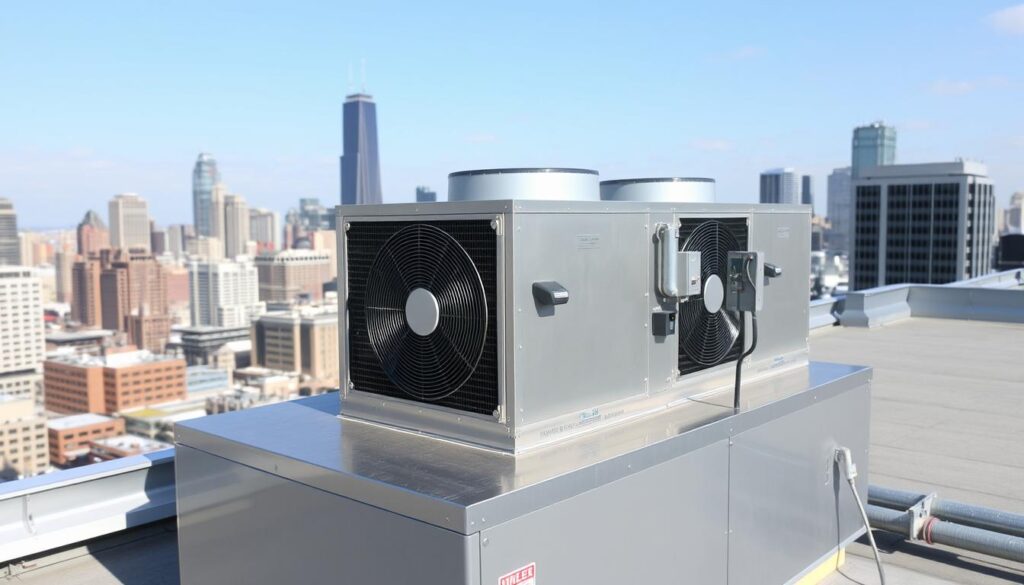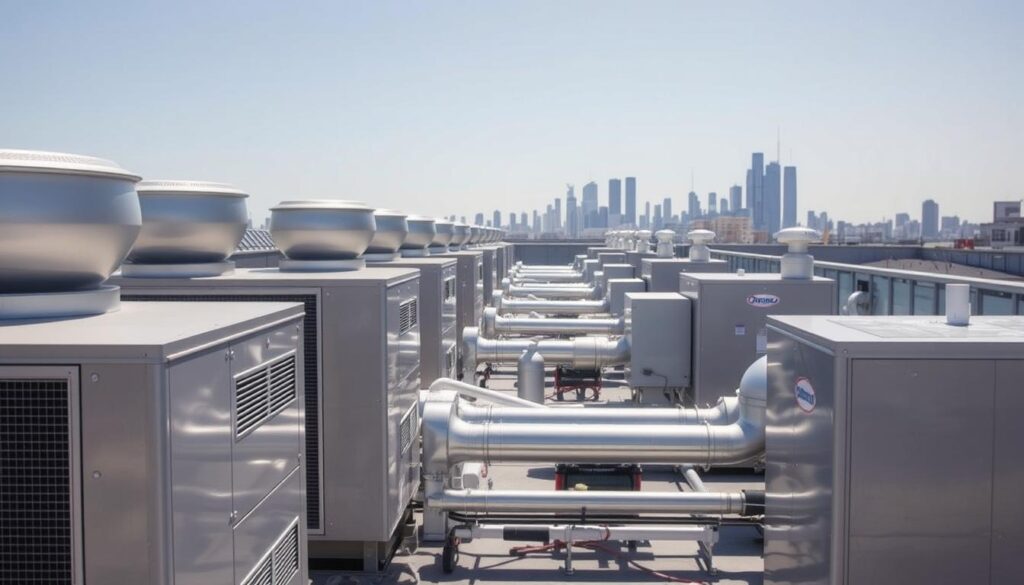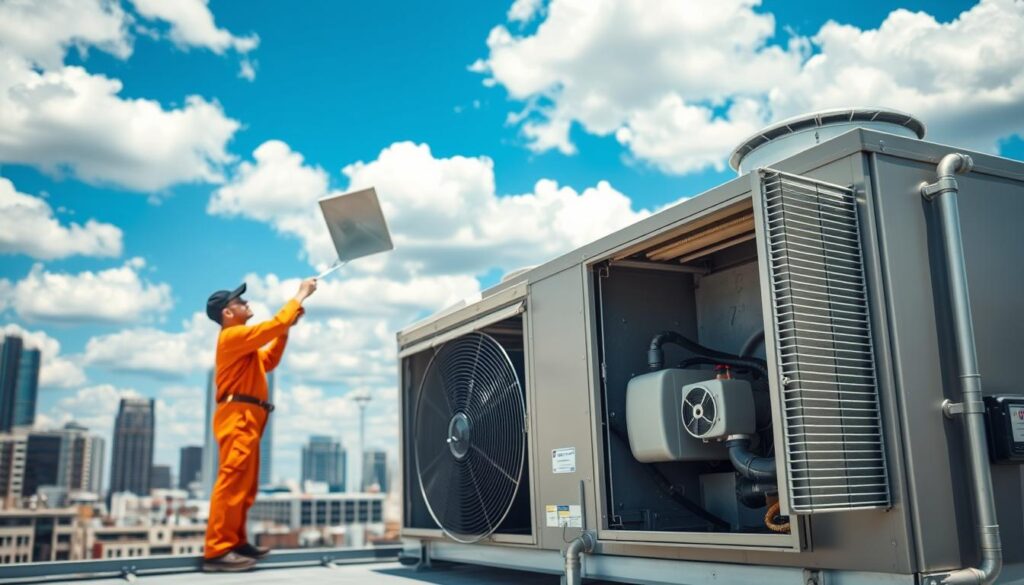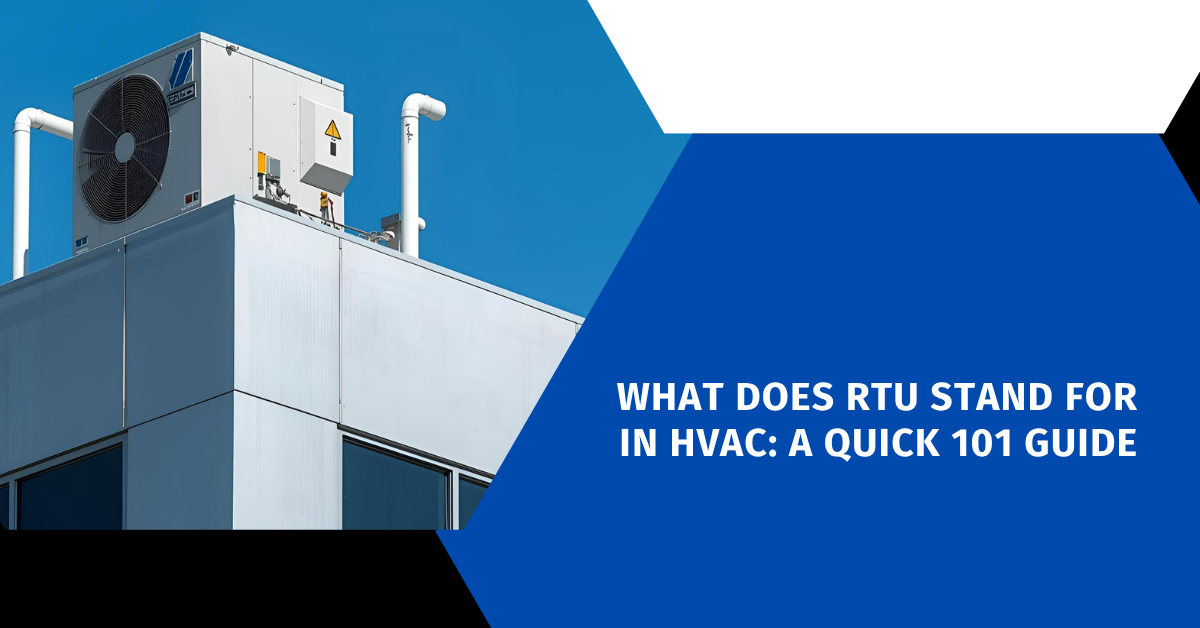Affiliate Disclosure
HVAC Guide Guys is a participant in the Amazon Services LLC Associates Program, an affiliate advertising program designed to provide a means for sites to earn advertising fees by advertising and linking to Amazon.
What Does RTU Stand For in HVAC? Ever seen the mysterious equipment on top of commercial buildings? It quietly controls the climate inside. These are the RTUs, the unsung heroes of comfort in our buildings.

RTU stands for Rooftop Unit in HVAC. It’s a system that handles heating, ventilation, and air conditioning all in one. It’s placed on the roof to keep indoor spaces comfortable in commercial and industrial areas across the U.S.
Knowing what RTU stands for in HVAC is more than just tech talk. It’s about understanding a key technology. It ensures comfort, saves energy, and boosts performance for businesses of all sizes.
Key Takeaways
- RTU means Rooftop Unit in HVAC systems
- Provides complete climate control for commercial buildings
- Strategically placed on building rooftops for maximum efficiency
- Integrates heating, cooling, and ventilation in one system
- Critical for maintaining indoor environmental quality
Table of Contents
What Does RTU Stand For in HVAC
Rooftop unit HVAC systems are key in modern commercial buildings. They offer heating, ventilation, and air conditioning all in one. This makes them perfect for various commercial spaces.
An rtu hvac definition is a self-contained system on a building’s roof. It combines many mechanical parts into one package. This makes it very versatile for different commercial settings.
Basic Definition and Purpose
Rooftop unit hvac systems do a lot:
- They control the climate in one unit
- They manage space well
- They keep temperatures steady
- They make indoor installation easier
Historical Development of RTUs
The history of rooftop units started in the mid-20th century. Engineers wanted to make cooling systems for commercial buildings more compact and efficient. They worked on using space better and making installation simpler.
“Innovation in HVAC technology has transformed how we manage building environments.” – HVAC Engineering Quarterly
Common Applications in Commercial Settings
RTU HVAC systems work great in:
- Retail stores
- Office buildings
- Warehouses
- Educational facilities
- Small to medium-sized commercial spaces
Their small size and all-in-one function make rooftop units perfect for businesses. They need efficient climate control without disrupting the interior too much.
Explore Our HVAC Shop
Looking for top-rated HVAC tools, parts, and accessories? Visit our shop and find the perfect solution for your needs.
Visit the ShopUnderstanding the Core Components of Rooftop Units
Packaged rooftop units (RTUs) are advanced air conditioning systems. They have many key parts working together for efficient climate control. Your rtu air conditioning system depends on a network of parts for the best performance and comfort.
- Air Handling Unit (AHU): The central processing system that manages air circulation and distribution
- Heating and Cooling Coils: Responsible for temperature regulation and heat exchange
- Control Systems: Intelligent interfaces that monitor and adjust unit performance
- Fans: Facilitate air movement throughout the system
- Filters: Capture dust, allergens, and particulate matter to maintain air quality
Each part is vital to your rtu air conditioning system’s efficiency. The air handling unit is the system’s heart, managing airflow and distribution. Heating and cooling coils keep temperatures right, and control systems always tweak performance.
Fans and filters are the final pieces, making sure air is clean and conditioned. They help air move well in commercial spaces. Knowing about these parts shows how amazing modern HVAC systems are.
Explore Our HVAC Shop
Looking for top-rated HVAC tools, parts, and accessories? Visit our shop and find the perfect solution for your needs.
Visit the ShopHow RTU Systems Function in Commercial Buildings
Commercial RTU systems are key to keeping indoor spaces comfy and energy-smart. They handle air quality, temperature, and ventilation with great accuracy.
Let’s dive into how these systems work. RTU systems are different from old air handling units. They offer better air management and save energy.
Air Distribution Process
The air distribution process in RTU systems includes several steps:
- Drawing fresh outdoor air into the system
- Filtering and conditioning the air
- Circulating treated air throughout the building
- Removing stale or contaminated air
Temperature Control Mechanisms
Keeping the right temperature is vital for RTU systems. They use advanced sensors and controls to:
- Detect current indoor temperature
- Compare it with preset desired temperature
- Activate heating or cooling components
- Maintain consistent thermal comfort
Ventilation Management
Good ventilation is essential for clean indoor air. RTU systems manage ventilation by:
- Controlling air exchange rates
- Monitoring CO2 levels
- Introducing fresh outdoor air
- Removing indoor pollutants
RTU systems use advanced air handling tech. They ensure the best environment while saving energy.
Benefits and Advantages of RTU HVAC Systems

Trane RTU models and other hvac rooftop equipment bring big benefits to commercial buildings. They offer efficient climate control solutions. This makes them a top choice for businesses.
The main advantages of rooftop units (RTUs) are:
- Space-Saving design: RTUs free up valuable indoor floor space by mounting equipment on the roof
- Simplified installation compared to traditional HVAC systems
- Enhanced energy efficiency
- Flexible configuration options
- Reduced maintenance requirements
Energy efficiency is a big plus of trane rtu models. These systems use advanced tech to cut down energy use. This helps commercial buildings save on utility costs.
Cost-effectiveness is another key benefit. The modular design of hvac rooftop equipment makes repairs and replacements easier. This saves businesses money on maintenance over time.
Modern RTU systems represent a smart investment for businesses seeking efficient and flexible climate control solutions.
Commercial property managers love the flexibility of rooftop units. They can be tailored to fit specific building needs. This provides scalable solutions for different space sizes and conditions.
Explore Our HVAC Shop
Looking for top-rated HVAC tools, parts, and accessories? Visit our shop and find the perfect solution for your needs.
Visit the ShopRTU vs Traditional HVAC Systems: Key Differences
Rooftop unit HVAC systems have changed the game for commercial climate control. They offer big advantages over old HVAC setups. When you learn what does RTU stand for in HVAC, you’ll see a complete solution for heating and cooling.
Rooftop unit HVAC systems are different from traditional systems in many ways:
Space Utilization Comparison
Old HVAC systems take up a lot of space inside. They have separate indoor and outdoor units. But rooftop units put everything in one spot on the roof.
- RTUs eliminate indoor equipment footprint
- Maximize usable interior square footage
- Provide flexible installation options
Installation Requirements
Installing rooftop unit HVAC systems is easier than traditional setups. Your building can benefit from:
- Faster deployment
- Reduced on-site construction time
- Simplified connection to building infrastructure
Maintenance Considerations
Maintenance for rooftop unit HVAC systems is a breeze. The all-in-one design makes it easy for technicians to access and service the system. They can check and fix everything without getting lost in complex indoor layouts.
Choosing a rooftop unit HVAC system means you’re going for a modern, efficient way to control the climate. It saves space, makes installation simple, and makes maintenance easy.
Energy Efficiency and Cost Savings with RTUs
Modern rtu air conditioning systems have changed how commercial buildings manage energy. Your business can save a lot by getting high-efficiency rtu systems. These systems use much less energy.
Being energy-efficient with rooftop units means big savings for your business. You can cut down on utility bills with smart upgrades and technology.
- Advanced variable-speed fans reduce electricity usage
- Programmable controls optimize temperature management
- Smart sensors minimize unnecessary energy expenditure
When picking rtu air conditioning systems, look for energy efficiency ratings. These ratings show how much you can save. The right systems can lower your costs and keep your space comfortable.
| Efficiency Feature | Annual Energy Savings | Cost Impact |
|---|---|---|
| Variable-Speed Motors | 20-30% | $2,500 – $4,000 |
| Smart Thermostat Integration | 10-15% | $1,200 – $2,000 |
| Advanced Insulation | 5-10% | $600 – $1,500 |
Buying energy-efficient rtu air conditioning is a smart financial move. It saves you money and makes your system work better.
Explore Our HVAC Shop
Looking for top-rated HVAC tools, parts, and accessories? Visit our shop and find the perfect solution for your needs.
Visit the ShopInstallation Requirements and Considerations
Installing hvac rooftop equipment needs careful planning. You must understand the key factors for safe, efficient, and compliant installation. This ensures your packaged rooftop units work well.
Roof Structure Requirements
The roof’s strength is critical for hvac equipment installation. You should think about:
- How much weight the roof can hold
- If the roof can be strengthened
- If the roof material is compatible
- The weight of the rooftop units
Access and Safety Considerations
Installing rooftop units safely is essential. You need to:
- Make sure there’s a safe way to get to the roof
- Put up strong safety railings
- Ensure the roof is stable
- Use fall protection systems
Building Code Compliance
Following local and national rules is key for rooftop equipment installation. A professional can help make sure you meet:
| Compliance Area | Key Requirements |
|---|---|
| Structural Integrity | Meet local building codes for weight and mounting |
| Electrical Standards | Follow NEC wiring regulations |
| Ventilation | Adhere to ASHRAE ventilation guidelines |
Getting professional advice is a good idea to handle these complex steps well.
Maintenance Best Practices for RTU Systems

Keeping rooftop units (RTUs) in top shape is key for your HVAC system’s performance and life. Knowing what an rtu hvac is shows how vital regular upkeep is for these essential units.
Your RTU maintenance plan should cover a few main points to keep your systems efficient:
- Regular filter replacement
- Comprehensive system inspections
- Coil cleaning procedures
- Electrical connection checks
- Refrigerant level monitoring
Having a regular maintenance plan can stop sudden failures and make your RTU last longer. Experts suggest the following maintenance schedule:
| Maintenance Task | Recommended Frequency |
|---|---|
| Air Filter Replacement | Every 3-6 months |
| Coil Cleaning | Twice per year |
| Comprehensive System Inspection | Annually |
Choose maintenance services with techs who know trane rtu models and commercial HVAC systems well. Professional maintenance can save a lot of money by avoiding big system problems and keeping energy use high.
Regular maintenance is not an expense—it’s an investment in your building’s comfort and operational performance.
By sticking to these best practices, your rooftop unit will keep your commercial space warm and cool.
Explore Our HVAC Shop
Looking for top-rated HVAC tools, parts, and accessories? Visit our shop and find the perfect solution for your needs.
Visit the ShopCommon RTU Problems and Troubleshooting
Rooftop units (RTUs) in HVAC systems face many technical issues. Knowing what a rooftop unit is in HVAC helps managers fix problems fast. This is key to keeping systems running well.
RTUs have special problems because they’re outside. They need specific fixes to work right. This is different from AHU systems.
- Refrigerant Leaks: These big problems cut down cooling power a lot.
- Fan Motor Failures: These stop air from moving and hurt system work.
- Control System Malfunctions: These mess up temperature control.
- Electrical Connection Problems: These make the system work on and off.
Spotting warning signs early stops big damage and saves money. Look out for these signs:
- Strange noises when it’s running.
- Temperature not staying steady.
- Using more energy than usual.
- Less air moving around.
Some small problems can be fixed by you. But big ones need a pro HVAC tech. Keeping up with maintenance and fixing issues fast keeps your unit working well for longer.
Conclusion
Rooftop unit HVAC systems are key for keeping commercial buildings cool. What does RTU stand for in HVAC? RTU stands for Rooftop Unit, a system that heats, ventilates, and cools commercial spaces efficiently.
Investing in rooftop unit HVAC systems brings many benefits. They save space, install easily, and manage energy well. Choosing an RTU means you get a system that fits many commercial needs, keeping your space comfortable and air clean.
Keeping your RTU system in top shape is essential. Regular checks, filter changes, and maintenance help it last longer and work better. As technology improves, RTU systems will be even more important for keeping buildings cool and green.
Knowing about rooftop unit HVAC systems helps building owners make smart choices. By picking the right HVAC, you can make your commercial space comfortable, efficient, and cutting-edge.

